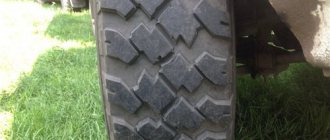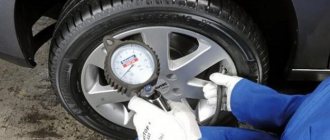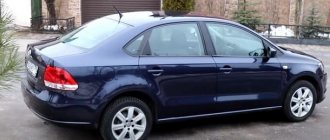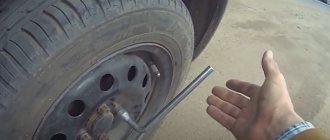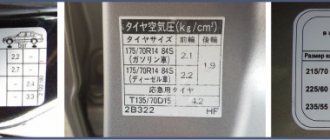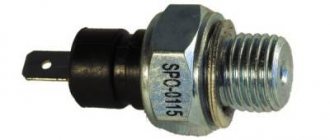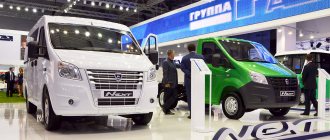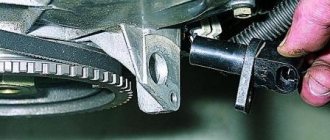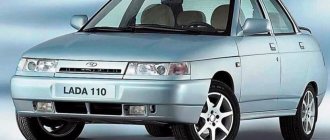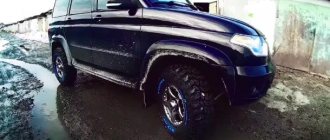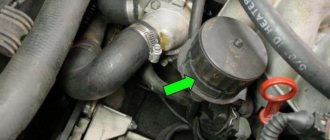On a Hyundai Solaris car, tires are installed according to size, depending on the modification. So in the Base and Classic configurations there are 15-inch steel wheels. Optima is equipped with both 15 and 16 inch.
The Comfort and Family versions have rims measuring 16 inches. However, the manufacturer does not prohibit putting wheels on rims measuring 17 and 18 inches. The car owner chooses the rim diameter individually, depending on the operating conditions of the vehicle.
What tire sizes does the manufacturer recommend to install?
The choice of tires is a real problem for most Hyundai Solaris owners due to the fact that the “range of sizes” is limited. Driving for a long time on tires with inappropriate sizes leads to decreased vehicle control and emergency situations.
| Wheel disks | Tires |
| 15ET45 | 205/60R15 |
| 15ET44 | 195/70R15 |
| 16ET45 | 205/65R16 |
The transcript reads as follows:
- wheel rim width;
- surface diameter;
- reach length;
- tire width;
- height in percent;
- diameter of the metal rim.
The higher the disc is installed on the car, the greater the risk of skidding and reduced control efficiency. At the same time, excessively low wheels also negatively affect ground clearance, lower ground clearance, and limit the vehicle’s maneuverability.
Brief summary
So, when preparing your car for the winter season and, in particular, choosing tires for Solaris, you need to:
- correctly determine and select the technical and dimensional characteristics of future tires based on the parameters of the rims on your Hyundai;
- analyze the most common road situations when traveling (ice, slush, city central roads cleared of snow, and so on), in order to determine the need for studs on a future new item;
- choose a tire manufacturer and model that suits your driving style, operating conditions and wallet capabilities.
And, most importantly, you need to remember that correctly selected tires are a matter of not only comfort, but also safety.
779
What is the tire pressure for Hyundai Solaris?
Each tire manufacturer determines the pressure for tires individually, based on their technical indicators and characteristics. Exact data is always indicated in the vehicle's operating manual.
| Name | Atmospheres (Bar) |
| Front (summer) | 2.1 |
| Rear (summer) | 1.9 |
| Front when fully loaded | 2.4 |
| Rear at full load | 2.8 |
| Winter (front/rear) | 2.2 / 2.1 |
Advertisements on NN.RU – Auto
Manufacturing of a broken-type platform with retractable ramps on the GAZ-33023 Gazelle-farmer chassis. Technical characteristics of the tow truck.
With us you can not only extend the frame to fit a body of 5.1 m, 6.2 m, 7.5 m, 9 m for Maz Zubrenok, Maz, Kamaz, Ural, Zil, Mitsubishi, Nissan.
A specialized company for the conversion of trucks produces extensions for man man, iveco and iveco truck tractors.
A certified truck conversion organization invites you to: lengthen, re-extend and convert, p.
New Year is a magical holiday. Everyone wants to please with a pleasant gift. The main thing is to correctly distribute expenses: to please everyone.
Review of the best summer and winter tires for Hyundai Solaris
The most popular winter tires:
- Vredestein Wintrac Xtreme S - the tread consists of Velcro, which provides maximum traction on wet asphalt and loose snow. The maximum temperature of use is 25°C. The critical point is -35°. The average cost in online catalogs is from 8,500 rubles.
- Goodyear UltraGrip Performance Gen-1 - balanced price-quality ratio. The tire provides good traction on loose snow and ice at sub-zero temperatures. Average price from 7,000 rubles.
- Dunlop Winter Sport 5 is a soft compound rubber that is not susceptible to hardening when the temperature drops. The price of one tire is from 5,500 rubles.
- Pirelli Winter Sottozero 3 is a popular model among car enthusiasts in the CIS, including the Russian Federation. Good quality, technical specifications at an affordable price. The service life before replacement exceeds 60 - 70 thousand km. mileage The average price by region is from 5,000 rubles.
- Nokian WR D4 is an economical option for most car owners. High-quality grip, long service life, affordable price from 2900 rubles.
Summer tires for Hyundai Solaris:
- Goodyear Ecient is a high-quality tire at a premium price from a European manufacturer. The tire warms up within a few seconds, providing the widest possible contact patch with the road surface. Rubber guarantees grip, control, cornering, and a minimum percentage of skidding at medium and high speeds. Average price from 5000 rubles.
- Grip Performance is a budget option from a European brand. Better than standard tires in terms of technical characteristics, acceptable for use in urban conditions. Price from 5500 rubles.
- Hankook Ventus Prime3 K125 is also a budget model with a price starting from 6,000 rubles. Above average quality at an affordable price.
- Dunlop SP Sport MAXX RT2 is a tire with unidirectional tread, which ensures high handling and minimal vehicle roll when cornering, regardless of weather conditions and temperature conditions. Average cost from 5200 rubles.
- Dunlop SP Sport MAXX RT - tires are similar to the previous ones, except that the tread pattern is asymmetrical. Price from 5100 rubles.
- Pirelli P7 Cinturato Blue - long service life is the main highlight of the rubber. The average service life exceeds 65,000 km before replacement. Average price from 5500 rubles.
Service station specialists strongly recommend changing tires strictly according to the seasons, and to a lesser extent using universal, all-season tires. The operating temperature range is several degrees lower than seasonal tires, resulting in reduced vehicle controllability.
Indexes and tire sizes for Hyundai Solaris
To choose the right tire you need to be able to read the indices and other symbols on the tires, namely:
- “T” - the maximum permitted speed of movement is not more than 195 km / h. “H” - up to 205 - 210 km/h. It is not recommended to exceed the speed range, as there is a high probability of shooting, cord deformation, and, as a result, an emergency;
- “Q” - load capacity index: from 85 to 490 kg;
- “ET” is the metal rim bead extension coefficient;
- “KM” - partial and full load index: no more than three passengers, cargo in the trunk up to 50 kg;
- “M+S” - full load - more than three people and over 50 kg in the trunk.
What does tire pressure affect?
- Safety and comfort when traveling by car.
- Fuel consumption: the lower the pressure, the more effort the engine needs to put in to rotate the wheel and move the car.
- Chassis and suspension of the vehicle.
- Shock absorbers and strut pressure springs.
Disconnect and reconnect your car battery
Your car has an on-board computer that checks all the sensors in the car (such as tire pressure monitoring system sensors) and decides what to do with that information. Just like your computer at home, sometimes electronics can experience system glitches. The fastest and easiest way to solve the problem of a computer crash is to restart it. Unfortunately, in order to reboot the computer in your car, you will have to first disconnect it from the power supply. To do this, you will need to briefly disconnect the negative (-) terminal of your car's battery.
First, open the hood of your car. Locate the battery and disconnect the negative cable from the battery. To do this you will need a wrench. After this, get into the car, turn on the ignition without starting the engine, and press the horn for about three seconds. This will drain any remaining energy stored in the vehicle's electrical system. Next, connect the negative cable back to the battery.
How the pressure sensor works, how to turn it off
Starting from the second generation, Hyundai Solaris is equipped with electronic tire pressure sensors. The first generation has mechanical sensors. Due to insufficient efficiency and information content, the latter were replaced by modern ones.
The main task of the digital gadget is to monitor changes in air pressure in the tire and transmit data online to the electronic control unit. The latter compares the indicators with the programmed ones and informs the driver about a possible malfunction. Most often, this is a sound signal combined with light flickering.
Principle of operation
- A pressure measuring sensor is installed on the inside of the tire. This must be done with the wheel lowered.
- After activation, the controller measures the pressure every 3 seconds and sends the data to the ECU. Bluetooth technology is used as a means of communication.
- The electronic control unit analyzes the obtained indicators for each of the wheels and compares them with the specified parameters.
- The end result can be duplicated on a smartphone if a special application is installed on the latter.
How to disable pressure sensors
There is no such thing as deactivating a sensor for the reason that it is impossible, since the absence of equipment must be registered at the system level. In case of unauthorized deactivation of the controller, “Error” is displayed on the dashboard.
Some car owners practice physically dismantling controllers in a service station. Do not try to do this on your own, as unprofessional intervention does not guarantee full functionality of the electronic control unit.
Sensor sensitivity
- Sudden surges in pressure due to falling into a hole or road bump;
- Critical low/high pressure;
- Installation of rubber tires that are larger or smaller than the recommended standards;
- Installing a damaged tire;
- Uneven distribution of load on the axle, passengers in the vehicle interior;
- Systematic operation of the controller during lifting and lowering of the machine;
- Metal chains are installed on rubber tires.
Choosing the right tires
After the dimensional characteristics of the new tires have been determined, the next important step will be to get rid of the illusions and temptation to purchase the so-called “all-season tire,” which, according to some car enthusiasts, is good even at +30 on hot asphalt and stable at -25 on ice. The temperature range and weather conditions at different times of the year in our country are too extreme for such tires. Still, it is intended for milder conditions.
And in his first winter season, for a young Solaris driver, wheels equipped with studs are simply a must-have. For all their noise, they have an undeniable advantage - when hitting the ice, such a wheel will behave most predictably of all other possible options, such as “all-season wheels”. Studded wheels can cause difficulties and troubles only at very high speeds, which in themselves are not logical in the winter season.
“Particularly experienced” and economical drivers prefer to seasonally replace tires on only two drive wheels. Both experts and traffic police officers strictly recommend using one set of tires at any time of the year, i.e. identical in type, size, pattern and tread height.
Some Hyundai Solaris owners prefer to change the wheels themselves. However, even if we are talking about a simple “transfer” of two fully shod sets, it is still worth contacting a reputable service station, where the appropriate work on wheel balancing will be carried out and the necessary recommendations on the use of tires will be given.
Wheel bolt pattern
The bolt pattern of the Hyundai Solaris is another important point when choosing wheels. This parameter is sometimes also called drilling. It consists of two numbers of the form X*X and is denoted by the abbreviation PCD in disc labeling. Shows the number of bolts on which the wheel is attached and the diameter of the circle on which they are located. On passenger cars, four to six studs are typically used.
For Solaris, the PCD value is 4*100, which means that the wheel is mounted on four bolts located on a circle with a diameter of 100 mm. The wheels of the Kia Rio, a classmate from another Korean manufacturer, have the same bolt pattern. The hub hole in the disk has a diameter of 54.1 mm, the thread on the studs is M12*1.50. This type of thread is widespread and is found on many cars. Its value should help when choosing flare nuts for securing wheels. The hub hole may be larger than specified.
Bolt pattern Hyundai Solaris 4*100
Since there are few wheels with a 4*100 bolt pattern with a diameter of more than 16″ on sale, sometimes the question arises as to whether it is possible to change the PCD, for example to 5*114.3 like in the Sonata, Tussant and other high-school models. Such wheels would look more interesting, and a fifth bolt would obviously not hurt - the fastening would be more reliable. But the main thing, of course, is that for such a bolt pattern you can find many options for 16″, 17″ and even 18″ wheels. Unfortunately, this is difficult to implement and very expensive, so the activity attracts only true enthusiasts. Most likely you will need to replace the hubs, brake discs, and calipers. You also need to pay attention to the fact that the hubs must fit the drive shafts. The bill runs into tens of thousands of rubles without taking into account the cost of the wheels themselves, which in the case of Solaris is quite expensive.
Possible negative factors
In addition to the fact that such factors affect the performance and life of your vehicle, it is also unsafe. Therefore, such problems should not be neglected.
Agree, it is much more profitable to prevent a problem than to spend money on repairing it later. Therefore, a technical inspection of your vehicle should be carried out in a timely manner.
Is the most important thing drivers can do for their tires. In just one month, a tire can lose up to 0.3-0.5 atmospheres of air pressure. It is important to check the air pressure regularly to ensure that your Nissan's tires are not under-inflated or over-inflated at the same time.
| Automobile model | Years of production | Tire size | Front tire pressure (atm./psi) | Rear tire pressure (atm./psi) |
| 2010-2014 | 205/60 R16 | 2,3/33 | 2,1/30 | |
| Juke | 2010-2014 | 215/55 R17 | 2,5/36 | 2,2/32 |
| Pixo | 2009-2014 | 155/65 R14 | 2,2/31 | 2,0/29 |
Micra (K11) | 1992-2002 | 155/70 R13 | 2,2/31 | 1,9/27 |
| Micra (K11) | 1992-2002 | 175/60 R13 | 2,2/31 | 1,9/27 |
| Micra (K11) | 1992-2002 | 165/60 R14 | 2,3/33 | 2,0/29 |
| Micra (K12) | 2003-2010 | 165/70 R14 | 2,4/34 | 2,2/31 |
| Micra (K12) | 2003-2010 | 175/60 R15 | 2,4/34 | 2,2/31 |
| Micra (K12) | 2003-2010 | 175/65 R15 | 2,4/34 | 2,2/31 |
| Micra (K12) | 2003-2010 | 185/50 R16 | 2,4/34 | 2,2/31 |
| Micra (K13) | 2010-2014 | 185/55 R16 | 2,3/33 | 2,3/33 |
Almera | 2000-2007 | 185/65 R15 | 2,0/29 | 2,0/29 |
| Almera | 2000-2007 | 195/60 R15 | 2,0/29 | 2,0/29 |
| Almera | 2000-2007 | 195/55 R16 | 2,0/29 | 2,0/29 |
| Leaf | 2010-2014 | 205/55 R16 | 2,5/36 | 2,5/36 |
Primera (P11 - 144)Nissan Teana | 2008-2014 | 205/65 R16 | 2,2/32 | 2,0/29 |
| Nissan Teana | 2008-2014 | 215/55 R17 | 2,2/32 | 2,0/29 |
| Almera Tino | 2000-2006 | 195/65 R15 | 2,0/29 | 2,0/29 |
| Almera Tino | 2000-2006 | 205/55 R16 | 2,0/29 | 2,0/29 |
| Serena | 1992-2002 | 175/80 R14 | 2,5/36 | 2,5/36 |
| Serena | 1992-2002 | 215/80 R15 | 1,8/26 | 2,2/31 |
| 2009-2011 | 195/60 R15 | 2,3/33 | 2,1/30 | |
| Cube | 2009-2011 | 195/55 R16 | 2,3/33 | 2,1/30 |
| Cube 1.5 dCi | 2009-2011 | 195/60 R15 | 2,5/36 | 2,3/33 |
| Cube 1.5 dCi | 2009-2011 | 195/60 R16 | 2,5/36 | 2,3/33 |
Qashqai (5-seater) | 2007-2014 | 215/65 R16 | 2,3/33 | 2,1/30 |
| Qashqai (5-seater) | 2007-2014 | 215/60 R17 | 2,3/33 | 2,1/30 |
| Qashqai (5-seater) | 2007-2014 | 215/55 R18 | 2,3/33 | 2,1/30 |
| Qashqai + 2 (7-seater) | 2007-2014 | 215/65 R16 | 2,3/33 | 2,3/33 |
| Qashqai + 2 (7-seater) | 2007-2014 | 215/60 R17 | 2,3/33 | 2,3/33 |
| Qashqai + 2 (7-seater) | 2007-2014 | 215/55 R18 | 2,3/33 | 2,3/33 |
Nissan Pathfinder | 1995-2014 | 235/70 R16 | 2,3/33 | 2,1/30 |
| Nissan Pathfinder | 1995-2014 | 255/70 R16 | 2,3/33 | 2,1/30 |
| Nissan Pathfinder | 2005-2014 | 255/65 R17 | 2,3/33 | 2,1/30 |
X-Trail (T30) | 2001-2007 | 215/70 R15 | 2,0/29 | 2,0/29 |
| X-Trail (T30) | 2001-2007 | 215/65 R16 | 2,0/29 | 2,0/29 |
| X-Trail (T31) | 2007-2014 | 225/60 R17 | 2,3/33 | 2,1/30 |
| X-Trail (T31) | 2007-2014 | 225/55 R18 | 2,3/33 | 2,1/30 |
| X-Trail (T31) | 2007-2014 | 225/55 R18 | 2,3/33 | 2,1/30 |
| X-Trail (T31) | 2007-2014 | 215/65 R16 | 3,1/44 | 3,1/44 |
| Terrano II | 1993-2008 | 215/80 R15 | 1,8/26 | 2,2/32 |
| Terrano II | 1993-2008 | 235/65 R17 | 1,8/26 | 1,8/26 |
Murano | 2005-2008 | 225/65 R18 | 2,3/33 | 2,3/33 |
| Patrol GR | 1998-2011 | 235/80 R16 | 1,8/26 | 2,7/39 |
| Patrol GR | 1998-2011 | 265/70 R16 | 2,0/29 | 2,5/36 |
| Pick-up/Navara | 1998-2013 | 185/80 R14 | 3,1/44 | 4,1/58 |
| Pick-up/Navara | 1998-2013 | 205/80 R16 | 2,9/41 | 3,6/51 |
| Pick-up/Navara | 1998-2013 | 255/65 R17 | 2,2/31 | 2,5/35 |
| Pick-up/Navara (D40) | 2005-2014 | 235/70 R16 | 2,5/35 | 2,5/35 |
| Pick-up/Navara (D40) | 2005-2014 | 255/65 R17 | 2,5/35 | 2,5/35 |
| Kubistar | 2003-2009 | 165/70 R14 (reinforced tires) | 2,5/35 | 3,1/44 |
| Kubistar | 2003-2009 | 165/70 R14 | 2,7/38 | 3,5/49 |
| Kubistar | 2003-2009 | 165/75 R14 | 2,2/32 | 3,2/46 |
| Kubistar | 2003-2009 | 175/65 R14 | 2,2/31 | 2,7/38 |
| NV200 | 2009-2014 | 175/70 R14 | 2,5/35 | 2,5/35 |
| Primastar | 2002-2014 | 195/65 R16 | 3,5/49 | 3,8/54 |
| Primastar | 2002-2014 | 215/65 R16 | 3,2/45 | 3,5/49 |
| Interstar | 2002-2010 | 195/65 R16 | 3,9/55 | 3,9/55 |
| Interstar | 2002-2010 | 225/65 R16 | 3,9/55 | 4,5/64 |
| Interstar | 2002-2010 | 215/65 R16 | 4,0/57 | 4,3/62 |
| Cabstar | 2004-2006 | 195/70 R15 | 4,3/61 | 4,3/61 |
| Cabstar | 2004-2006 | 185/75 R16 | 4,8/69 | 4,7/67 |
| NV400 | 2011-2014 | 225/65 R16 | 3,9/55 | 4,6/65 |
A little about the car
Eight years is a sufficient period for car owners to comprehensively study and evaluate any car. And if the decision is made to release the next generation, it means that everything went as it should, sales are going well and all that remains is to take into account the opinions of the consumer, making the car even better. This is exactly what happened with the Hyundai Solaris.
Since this is a small class B city car, it was equipped with only two options for small engines - 1.4 and 1.6 liters. The first option, with a power of only 107 hp. was not in great demand, and therefore the number of its sales was significantly lower.
However, to work with a more powerful 1.6l engine, the automatic transmission was clearly not enough, which was the reason for some modifications to the model.
In particular, Hyundai has modernized the rear suspension several times, which has helped improve the car's stability when driving and eliminate sway on poor-quality road surfaces.
In the basic configuration, Solaris was equipped only with a 1.4 liter engine with a manual transmission, steel wheels (wheel diameter 14 inches) and only one airbag. No other security systems, including anti-lock ones, were installed on them.
Solaris 2011 (1st generation)
Three years later (in 2014), the car was restyled, and in the middle of the year the updated version was already on sale. The changes affected the gearbox, which added the number of steps, an electrical part, a steering wheel that became conveniently adjustable for reach, and new body painting options appeared.

